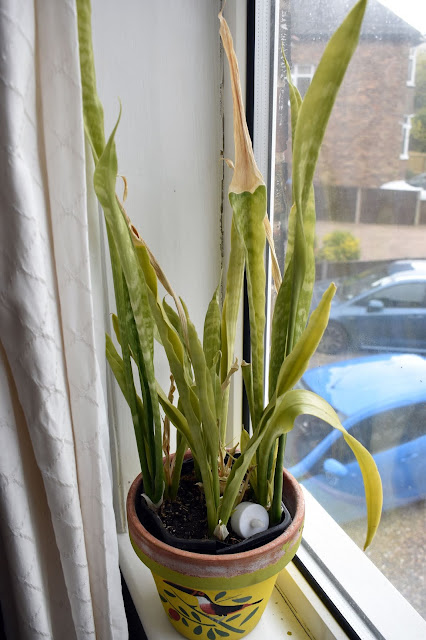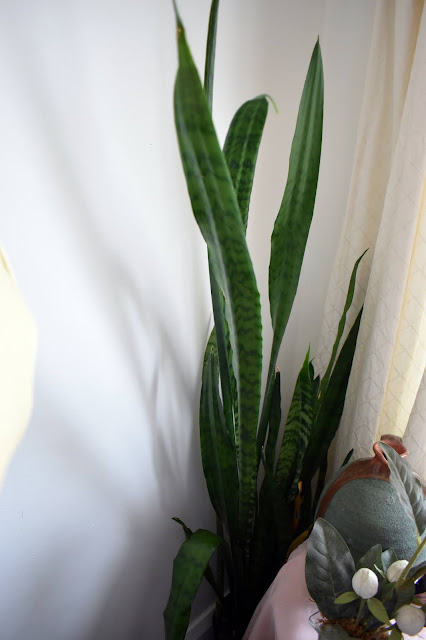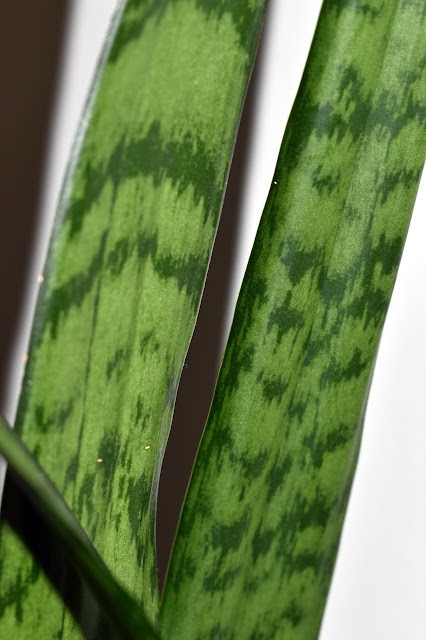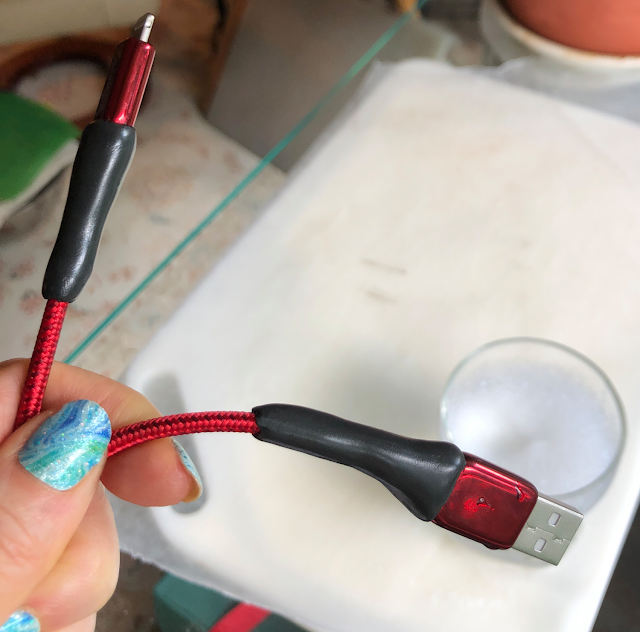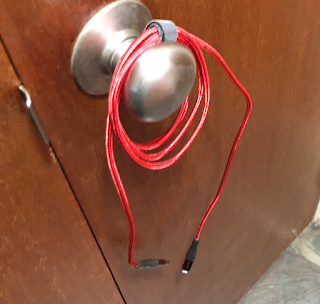Apple Lightning cables, Thunderbolt cables, and several types of USB cables
remain in widespread use, despite the prevalence of Bluetooth wireless
technology. You probably own multiple chargers and other types of cables to
power, recharge and connect your mobile phones, digital cameras, tablets,
e-readers, laptop or desktop computers, wired printers and other electronic
equipment and peripherals, whether or not they are Bluetooth-enabled.
If you are frustrated by how often even expensive, top-rated phone chargers
and other charging cords and cables need to be repaired or replaced, you’ll
appreciate this quick, easy and inexpensive DIY hack that will strengthen and
significantly prolong the life of your charging cables and data transfer
cables. I’ll show you how to reinforce and extend the manufacturer’s built-in
strain relief for the connectors on the ends of these cords with a small,
single-use pack of Sugru moldable rubber glue and a few minutes of your time.
There's no way to predict exactly how much longer yours will last with this
hack, since there are quite a few possible variables at play. However, I can
say that, as someone who tends to be pretty hard on iPhone charging cables,
USB cables and other cords for my various electronics and digital devices,
using Sugru to strengthen my new cables before I start using them has roughly
doubled the useful life of several of mine.
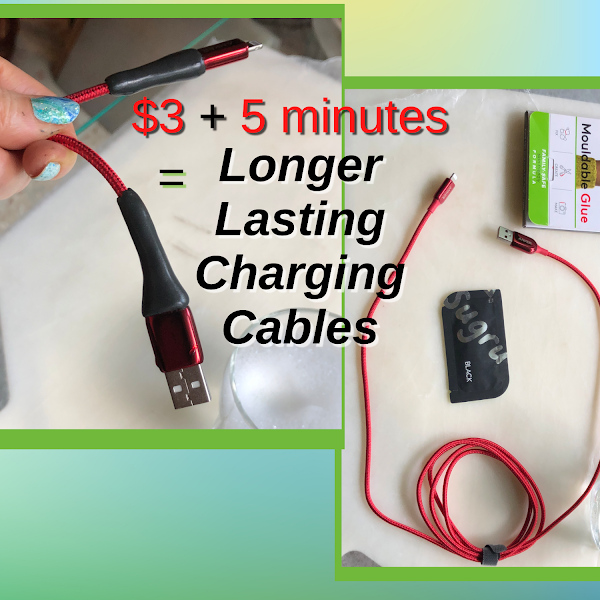
|
|
It took only a few minutes and less than $3 worth of Sugru moldable
rubber "glue" to reinforce and extend the strain release on this new
Anker Powerline+ III Apple Lightning to USB-A charging cable.
|
How Many Types of Charging Cables Do You Use?
USB cables are ubiquitous home, office and mobile device staples. In addition
to charging most of our electronic devices, these cords are also used to
transfer files and photos from a digital camera or mobile phone to a desktop,
laptop or tablet, send documents, images and other data to a regular,
multifunction or 3D printer, electronic cutting machine or other device with a
USB port, and to sync files, photos and other data among digital devices,
either instead or as an alternative to using Bluetooth or other wireless
technology options.
Most households own multiple mobile phones, tablets, computers, printers and
other digital devices that require different types of USB charging cables and
cords for data transfer. For example, I use both USB-A to Apple Lightning
cables and USB-C to Apple Lightening cables to charge my iPhone or transfer
data from my iPhone to my Windows laptop and a USB-A to USB-C cable to charge
my Fire HD 10 tablet, while my husband’s old Samsung Galaxy S5 Android phone
uses a Micro USB Type B to USB-A charging cable.
An Ounce of Prevention Is Worth a Pound of Cure
High-quality charging cables usually have more substantial, durable and
usually molded integral strain relief than cheap ones. However, even on better
quality USB charging cords from top brands such as Anker, if care isn’t taken
to avoid undue tension or torsion at the connector ends, the strain relief may
not be sufficient to prevent a wire in a shielded cable from breaking or stop
the insulation, shield and jacket layers that surround those wires from
splitting, fraying or separating from the connectors.
Using Sugru moldable glue to repair charging cords when the outer layers fray
or split has long been a popular hack. While encasing the cable ends and
connectors with this durable, air-cured rubber putty can sometimes extend the
lifespan of a cable with relatively minor surface damage, such as a frayed
cord or a small tear in the insulation, it can’t fix one that has stopped
working because of a loose or broken wire. So, instead of waiting until one of
these issues develops and having to attempt a DIY repair or pay a repair
service more money to fix the broken cord or charger than it would cost to buy
a new one, I highly recommend taking a more proactive approach by using Sugru
to reinforce the strain relief the manufacturer has added to a new cable as
soon as you remove it from the packaging. It's simple, inexpensive precaution
that can significantly extend or even double a laptop, tablet or phone
charger's useful life.
At the time of this post’s publication, you can order a
3-pack of Sugru moldable glue
on Amazon for $7.99 with free shipping for Amazon Prime members. That equates
to $2.66 for each single-use pack, which contains the perfect amount of Sugru
for this quick and easy DIY project. So, for less than $3 each, you can beef
up the strain relief to prolong the life of your new or lightly used charging
cables.
Since there are so many ingenious and useful Sugru hacks that use this strong,
adhesive, self-hardening rubber putty, you may want to order the more
economical
Sugru moldable multi-use glue 8-pack, available on Amazon for $16.99 with free Prime shipping as write this,
which brings down the cost of each pack to just $2.12 per (or even less with
the current $3 off coupon).
Another consideration: One single-use pack of Sugru is enough to reinforce two
cord ends. I prefer to reinforce both ends of my charging cables, so I use one
pack for each cable. However, many people reinforce only one end of each cord,
and if that's your preference, you can strengthen the strain relief on two
chargers with each single-use pack,
Note: If you aren’t a Prime member already, I highly recommend taking
advantage of the
Amazon Prime 30-day free trial. You can take a month to explore and enjoy the wide range of valuable
benefits of being an Amazon Prime member—plenty of time to decide whether or
not the annual membership fee would be worth it for you and your family.
Sugru: Use It or Lose It
Sugru begins to cure and morph from a soft putty to a hard rubber as soon as
it is exposed to air. So, the minute you tear open one of the foil pouches,
the clock starts ticking. According to the manufacturer's website, "Once you
open your single-use pack, the moisture in the air will trigger the setting
process giving you 30 minutes to fix, bond and create before Sugru begins to
harden." So, it's important to work quickly so you will have enough time to
complete and refine your project within that 30-minute window. [Source]
Since the company has not found yet found a way to extend Sugru's working time
once it is exposed to air, make sure you have everything set out and ready to
go before you open that airtight, sealed foil pouch. And, if you only need
part of the packet's contents for your project—for example, if you only want
to reinforce one end of a charging cable—try to plan another project (or two)
to use up the remainder of the Sugru during that 30-minute "open time" so none
of it goes to waste.
Even unopened Sugru has a limited shelf life and an expiration date that is
marked on the packaging. However, the good news is that Sugru was reformulated
last fall and one of the new formula's improvements is that you can increase
the product's shelf life as much as three times by storing the single-use
pouches in the refrigerator from the time you bring them home until you're
ready to use them.
How to Strengthen Your Charging Cables to Prolong Their Useful Life
Follow these simple, step-by-step instructions for reinforcing and extending
the manufacturer's existing strain relief collar or band with this easy $3
charging cable Sugru hack.
What You'll Need
-
One or more USB charging cords or other cables, new and unused (preferably)
or in excellent condition
-
One 3.5 g (0.12 oz) single-use pack of
Sugru Moldable Glue by Tesa
for each cable you want to reinforce
-
A countdown timer or timer app (optional but highly recommended), watch or
clock
-
PTFE Teflon non-stick sheet to protect your work surface (optional, but highly recommended—see
note)
-
A small container of lukewarm water mixed with a drop or two of mild liquid
dish soap or hand soap (optional)
-
I use my favorite
Puracy natural hand soap gel, which is gentle on my skin and smells wonderful. I buy the large 48-ounce refill bags and refill my hand soap dispensers.
Note: Teflon is one of the few materials that Sugru won't stick to before it
cures. Even if you prefer not to cook or bake with it, this nonstick sheet can
be extremely useful for crafting and DIY projects. Unfortunately, I couldn't
find mine recently when I was photographing this DIY tutorial, so I tried
substituting a sheet of wax paper to protect the cutting board I used as my
portable work surface. The Sugru glue did stick to the wax paper somewhat, so
I don't recommend it. If you don't have (or don't want to buy) a piece of
nonstick sheet for crafting and DIY, I suggest trying plastic wrap aka cling
film, which might work better.
Step 1: Set Up Your Workspace With Everything You Will Need Before You Open
the Pack of Sugru.
The second the Sugru inside a sealed foil pouch is exposed to air, the clock
starts ticking on the 30-minute window of working time before the rubber putty
starts to cure. So, it's a good idea to get as much set up as you can to
maximize that limited window of opportunity, before the countdown begins.
- Clear off a flat workspace and cover it with the nonstick sheet.
-
Remove the charging cord (or cords) from its packaging, loosen the
hook-and-loop fastener cable tie just enough to pull out the connector
end(s) you will be reinforcing for easy access, then re-tighten the cable
tie.
- Fill a small container with lukewarm soapy water, if using.
-
Set a countdown timer or app for 30 minutes, or put your watch. clock, or
mobile phone clock where you can see them.
-
Pull out a single-use pack of Sugru moldable glue in the color of your
choice, which can match, complement or contrast with the color of the
charging cord.
-
For this tutorial, I chose a pack of black Sugru to make it easy to
distinguish between the original strain relief collar band of the red
Anker Powerline+ III Lightning to USB-A charging cable and the new,
longer and thicker Sugru molded rubber reinforcement I added.
When everything is set up and ready to go, start the countdown timer (or make
note of the time) and cut or tear open the sealed foil pouch of Sugru. It's show
time!
Step 2: Remove the Sugru and Divide It in Half.
Lightly roll each half into a ball and then into a log or sausage shape long
enough to cover and extend past the charging cable's strain relief collar or
band, as shown.
Step 3: Taper, Flatten, Wrap and Shape a Sugru Log Around One End of the
Charging Cord.
Taper one of the Sugru logs slightly, then gently flatten it with your
fingertips until it's just wide enough to wrap around one end of the cable.
Align the wider end of the tapered, flattened Sugru log so it overlaps the
bottom edge of the connector or plug cover slightly. Then, wrap the edges of
the Sugru around the cord, lightly pressing and stroking the soft rubber putty
so it conforms smoothly, evenly and snugly and tapers gradually as it extends
past the strain relief band and onto the outer cord covering.
When you are happy with the shape of your molded rubber strain relief
reinforcement, stroke the surface lightly with a fingertip to smooth out any
bumps, seams or uneven edges.
If you want to further refine the appearance of your Sugru-enhanced cable
strain relief, you can dip your finger into some soapy water for the final
smoothing, which will allow your fingertip to glide over the surface of the
soft, sticky Sugru rubber to smooth away any fingerprints, lumps, bumps, or
unevenness.
You can see how much smoother and more refined the black Sugru wraps are on
this Anker Powerline+ III Lightning to USB-A iPhone charging cable compared to
the slightly lumpier, less evenly shaped red Sugru wraps on the Amazon Basics Nylon USB-A to Lightning Cable Cord, MFi Certified Charger
for Apple iPhone in the next photo, which I formed without the benefit of any soapy
water lubricant. The red Sugru strain relief hack looks fine, too, just a bit
less "finished."
Just make sure to keep and eye on the countdown clock, so you can leave enough
time to reinforce, shape and smooth the other end of the charging cord (or a
second charging cable) before the Sugru starts to cure and becomes harder to
form and refine.
Step 4: Repeat With the Remaining Sugru.
Repeat step 3, using the second log of Sugru to reinforce the other end of the
same cable or another charging cord.
Tip: If you are reinforcing both ends of the same cord, be careful not to let
the first newly-reinforced cord end bump into anything accidentally while you
are working on strengthening the strain relief on the other end, since the
Sugru will still be soft and easily marred. One big advantage of working on a
PTFE/Teflon sheet is that you can lay the first Sugru-covered end flat on the
nonstick sheet, where it can remain undisturbed (if you're careful not to
jostle it) as you form the remaining rubber putty around the other end of the
cable.
Step 5: Allow the Sugru Rubber-Reinforced Charging Cable(s) to Cure,
Undisturbed, For 12 to 24 Hours.
If you can arrange the cord(s) so that the reinforced ends lay flat against
the nonstick sheet-covered work surface, that's probably the easiest option.
Alternatively, you may be able to hang the cable over a wall hook, shower
curtain rod, towel rack, or even a doorknob, as I did, as long as the
still-soft Sugru cord ends don't touch anything, including each other until
the next day.
By the following day, the moldable rubber will be fully cured, providing much
more robust cord strain relief and helping to prolong the lifespan of the many
types of phone chargers and other charging cables that power and connect the
devices you rely on for information, education, communication, entertainment,
work and play.
This Easy $3 Hack Prolongs Your Charging Cables' Life by Margaret Schindel
Read More Product Reviews by Our Review This Reviews Contributors
Read More DIY Reviews by Our Review This Reviews Contributors
Note: The author may receive a commission from purchases made using links found in this article. “As an Amazon Associate, Ebay (EPN), Esty (Awin), and/or Zazzle Affiliate, I (we) earn from qualifying purchases.”






